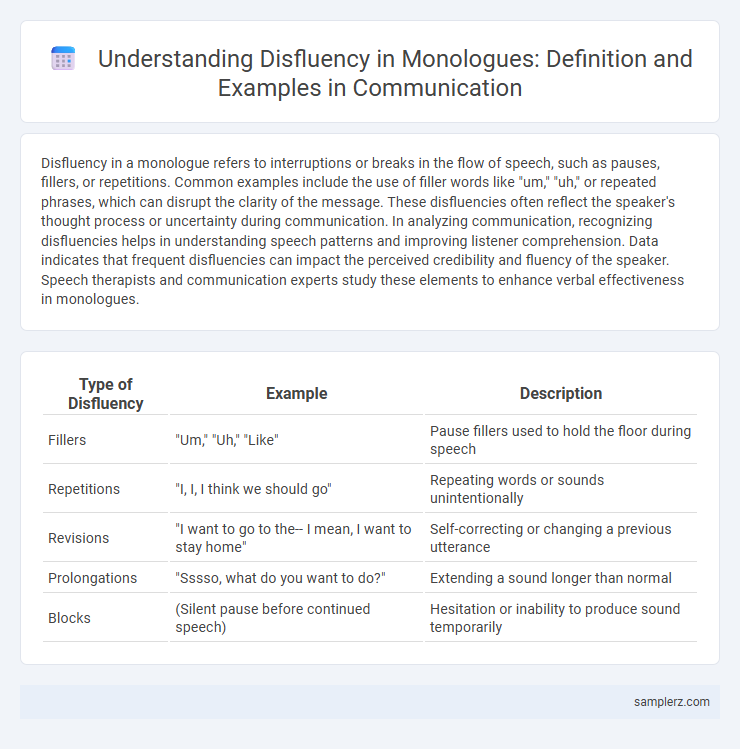Disfluency in a monologue refers to interruptions or breaks in the flow of speech, such as pauses, fillers, or repetitions. Common examples include the use of filler words like "um," "uh," or repeated phrases, which can disrupt the clarity of the message. These disfluencies often reflect the speaker's thought process or uncertainty during communication. In analyzing communication, recognizing disfluencies helps in understanding speech patterns and improving listener comprehension. Data indicates that frequent disfluencies can impact the perceived credibility and fluency of the speaker. Speech therapists and communication experts study these elements to enhance verbal effectiveness in monologues.
Table of Comparison
| Type of Disfluency | Example | Description |
|---|---|---|
| Fillers | "Um," "Uh," "Like" | Pause fillers used to hold the floor during speech |
| Repetitions | "I, I, I think we should go" | Repeating words or sounds unintentionally |
| Revisions | "I want to go to the-- I mean, I want to stay home" | Self-correcting or changing a previous utterance |
| Prolongations | "Sssso, what do you want to do?" | Extending a sound longer than normal |
| Blocks | (Silent pause before continued speech) | Hesitation or inability to produce sound temporarily |
Introduction to Disfluency in Monologue
Disfluency in monologue often manifests as pauses, filler words such as "um" and "uh," or repeated syllables that interrupt the smooth flow of speech. These interruptions provide insight into cognitive load and speaker hesitation during spontaneous verbal communication. Analyzing disfluency patterns helps improve speech recognition systems and enhances strategies for effective communication.
Common Types of Disfluency in Speech
Common types of disfluency in speech include fillers such as "um" and "uh," repetitions of words or phrases, and self-corrections where the speaker stops to revise their statement. These interruptions disrupt the natural flow of monologue, often reflecting cognitive processing or hesitation. Understanding these patterns aids in improving communication clarity and fluency.
Fillers: “Um,” “Uh,” and “Er”
Fillers such as "Um," "Uh," and "Er" frequently appear in monologues, signaling hesitation, uncertainty, or time taken to formulate thoughts. These disfluencies can disrupt the flow of speech and impact clarity, often reflecting the speaker's cognitive load or lack of preparation. In communication studies, analyzing the occurrence and frequency of fillers provides insight into speaker confidence and speech planning processes.
False Starts and Self-Corrections
False starts and self-corrections frequently occur in monologues, disrupting the fluency of speech by causing interruptions and delays in conveying ideas. For example, a speaker might begin a sentence with "I think we should... no, actually, we must consider..." which illustrates an immediate correction and adjustment of their initial thought. These disfluencies reflect the cognitive process of monitoring and revising language output, impacting the clarity and coherence of communication.
Repetitions in Spontaneous Monologues
Repetitions in spontaneous monologues often manifest as repeated words or phrases that speakers use to maintain fluency or buy time during speech production. For example, a speaker might say, "I, I think we should, should focus on the main issue," illustrating lexical repetition as a disfluency marker. These repetitions indicate cognitive processing challenges and are common in natural, unplanned communication contexts.
Pauses: Silent and Filled
Pauses in monologue communication demonstrate key types of disfluency, including silent pauses and filled pauses. Silent pauses are brief moments of silence that can indicate hesitation, cognitive processing, or the speaker's attempt to structure thoughts without vocal interruption. Filled pauses, such as "um," "uh," or "er," serve as vocal placeholders that help maintain the flow of speech and signal ongoing cognitive activity while the speaker searches for the right word or idea.
Prolongations and Drawn-Out Sounds
Prolongations and drawn-out sounds are common disfluencies in monologues, often occurring when speakers extend vowel sounds to buy time for word retrieval or planning. These vocal disruptions can manifest as stretched syllables, such as "I waaaant to explain," which may signal hesitancy or processing difficulty. Identifying such speech patterns is crucial for speech therapists aiming to improve fluency and communication effectiveness.
Discourse Markers as Disfluencies
Discourse markers such as "well," "you know," and "like" frequently appear as disfluencies in monologues, disrupting the flow of speech and signaling hesitation or uncertainty. These markers often fill pauses or serve as cognitive placeholders, reflecting the speaker's effort to organize thoughts in real time. Recognizing these disfluencies is essential for understanding natural spoken communication and improving speech processing systems.
Stuttering and Its Monologic Manifestations
Stuttering, a common disfluency in monologue, manifests through repetitions of sounds, syllables, or words, as well as prolongations and blocks that disrupt the natural flow of speech. These interruptions often result in increased speech effort and reduced fluency, impacting speaker confidence and listener comprehension. Monologic contexts particularly highlight the persistence of stuttering due to the absence of interactive feedback, making self-monitoring and speech planning more challenging.
Impact of Disfluency on Listener Perception
Disfluencies such as hesitations, fillers like "um" and "uh," and repetitions in monologues can diminish the speaker's perceived credibility and authority. These interruptions often disrupt the listener's cognitive processing, leading to reduced comprehension and engagement. Consequently, persistent disfluency may cause listeners to question the speaker's confidence and expertise.

example of disfluency in monologue Infographic
 samplerz.com
samplerz.com